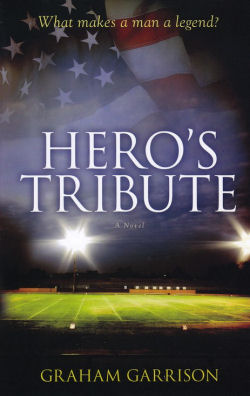|
The
manuscript for my first novel, Hero’s Tribute, was
returned to me stained in red. I’d just received the first round of
edits from the publisher, and as I thumbed through the pages, I noticed
that the chapter I’d enjoyed writing the most had a note posted at the
top. The chapter contained a few thousand words, basically a
description of the small town of Talking Creek: its high school
football team, tie-ins to the Civil War, and small liberal arts
university. The editors wanted to know if I could shorten the chapter
by a thousand words or so. In essence, I’d have to butcher it.
Within ten minutes I made the
quota.
It felt like ripping off a
Band-Aid really fast, but I didn’t mind. I’m so used to the red pen in
what I do as a magazine editor—cutting and slashing other people’s
stories—that I don’t hesitate to use it on myself. I spend my regular
work hours editing features, departments, and columns on the
health-care industry, rewriting articles from business professionals,
and rewriting press releases from manufacturers and distributors.
I’m in charge of the production
for three magazines, about thirty-seven issues each year, all told. In
addition, I handle the social media content for two of these magazines,
which includes blogs, posts, and releases three to five times a week.
On top of that, I do some freelance editing and writing for two sales
magazines: one geared toward veterinary medical distributors and the
other is for print reps.
Things don’t really ease up at
home, either. My wife, Katie, and I have two boys: a three-year-old
with an active imagination and two legs that don’t stop running, and a
nine-month-old who’s a couple days away from learning to crawl. I have
soccer practices to attend (who knew three-year-olds could play
organized sports), lawns to mow, hedges to trim, diapers to change,
bills to pay, diapers to change again, a beagle to chase around the
house … Every day is exhausting. But somewhere in those hours I find
time to write. Ironically, I’m writing more now than I ever have.
Part of the ability to write
among seeming chaos comes from my newspaper background. While at the
University of Georgia, I worked three years at the college paper, the Red
& Black (maybe that’s why I don’t fear the red),
where deadlines were drilled into me. I got a tip from one of the top
professors at the J-school, a former VP at the Associated Press, that
the more I put my byline in the newspaper, the more he’d pay attention
to me in class. Granted, some of the articles and columns I wrote were
terrible, but the experience of covering a beat and writing nearly
every day proved invaluable.
I was able to set my clips on
the table and compare them to the full-time reporters to see what I was
doing right and where I needed to improve. My first job out of college
was at a suburban newspaper where I churned out at least two articles a
day between commuting a thirty-mile circuit from high school sporting
events back to the office. I also dabbled in pagination to help the
copy desk. When I eventually transitioned to magazines, I felt like I
was going from a sprint to a trot. A whole two weeks to finish an
article? And book publishing feels absolutely glacial compared to
newspapers.
But the main benefit of the
newspaper pace was writing every day. Tons of people want to write a
book. I think they struggle in finding the time and the inspiration.
I wrote Hero’s Tribute
at night and on lunch breaks
over a six-month period, but this was before kids, a house, and a
publisher’s deadline. For the sequel, I signed the contract a few weeks
after I signed the paperwork to bring my second son home from the
hospital. Work responsibilities had increased too, so time management
was critical. I carved out a half hour before
|
work
(thus beating school
traffic), at lunch (thus eating less fast food), and even a little bit
at home (although by bath and pajama time, my wife and I were both
exhausted).
I
tracked the progress with a
series of outlines. The first outline was two columns and 12-point
type. It grew to three columns, shrunk to 10-point type then 8-point
type, and by the time summer came around, I’d put together a
75,000-word manuscript through twelve outline drafts.
Epiphanies are epiphanies
because they don’t happen every day. I discovered in Hero’s
Tribute, and especially with the sequel, that if I committed
to a block of time or a word count each day, the ideas went from a
trickle to a steady stream. Steven Pressfield, author of The
Legend of Bagger Vance and Gates of Fire,
calls this “feeding the muse.” It’s true; the more committed I was to
the process, the more the story developed.
I
didn’t need to write a chapter, pause, close out production of a
magazine, and then come back to the story. Don’t get me wrong,
epiphanies do help. I didn’t get the big plot twist for Hero’s
Tribute until about halfway through writing, and I can
remember clearly where I was when it happened, but it would have never
occurred if I hadn’t first put 30,000 words down on paper.
By far the most I’ve learned has
been through the editing process. I know most writers dread getting
back their manuscripts drenched in red ink and suggested revisions, but
I looked forward to it, mostly so I could see what the book editors
wanted out of the story. My mistakes and subsequent corrections helped
me gain an overall view of putting a manuscript together. There’s a
sense of comfort knowing someone is watching your characters and plot
for consistencies. It’s also helped to look at a manuscript in a
big-picture kind of way. I find myself doing that with my casual
reading more—writing descriptions of the characters and plot twists to
identify pacing and compare it to my own.
Book publishing is still pretty
new to me, so I’ve used the release of Hero’s Tribute and
the draft of the sequel as a learning process. Book promotion, for one,
was a foreign concept before last year. Building an audience is as
important as building a story. But as with my full-time job as an
editor, the revisions turn out to be as much fun as the first few
drafts.


|









